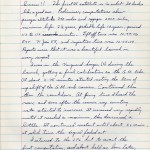The U.S. launched its first satellite, Explorer I, on this day 55 years ago, on January 31, 1958. Under the direction of Prof. James A. Van Allen of the University of Iowa’s Department of Physics, the satellite carried a payload of data-gathering equipment which eventually revealed the presence of radiation belts encircling the earth.
Our observation of this anniversary is bittersweet this year, as one of the Explorer I team’s most dedicated developers, George Ludwig, died at his Winchester, Virginia, home on Jan. 22 at the age of 85.
George Ludwig was a doctoral candidate working on the project with Prof. Van Allen at the time, and he kept a journal chronicling the events. In his entry made at 3:30 a.m. on Saturday, February 1, 1958, he declared:
“Success!! The first U.S. satellite is in orbit. It looks like a good one. … At about 12:41 (Eastern Standard Time) west coast stations started reporting signals. So it was around the earth once! … And so to sleep – the end of a beautiful day.”
Mr. Ludwig, a Johnson County, Iowa native who completed his doctoral dissertation in 1960, went on to a distinguished career with the Goddard Space Flight Center, and later helped lead the effort to establish the National Earth Satellite Service during the 1970s. In 1981 he became director of the National Oceanic and Atmospheric Administration’s Environmental Research Laboratories, a position he held for two years before returning to NASA. He retired in 1984.
His papers are now housed in the University Archives. In addition, the original data he gathered and analyzed from Explorer I, the first scientific data ever transmitted from space, is being digitized and will be made available online in its original raw form. Mr. Ludwig was part of a small, select group of space exploration pioneers whose research laid the foundation for today’s understanding of our planet, our solar system, and beyond.

